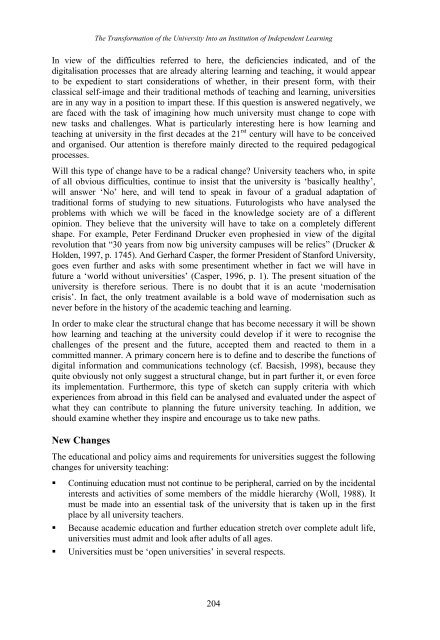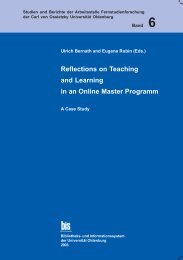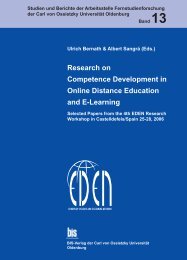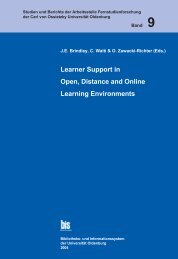Distance Education in Transition - Master of Distance Education ...
Distance Education in Transition - Master of Distance Education ...
Distance Education in Transition - Master of Distance Education ...
You also want an ePaper? Increase the reach of your titles
YUMPU automatically turns print PDFs into web optimized ePapers that Google loves.
The Transformation <strong>of</strong> the University Into an Institution <strong>of</strong> Independent Learn<strong>in</strong>g<br />
In view <strong>of</strong> the difficulties referred to here, the deficiencies <strong>in</strong>dicated, and <strong>of</strong> the<br />
digitalisation processes that are already alter<strong>in</strong>g learn<strong>in</strong>g and teach<strong>in</strong>g, it would appear<br />
to be expedient to start considerations <strong>of</strong> whether, <strong>in</strong> their present form, with their<br />
classical self-image and their traditional methods <strong>of</strong> teach<strong>in</strong>g and learn<strong>in</strong>g, universities<br />
are <strong>in</strong> any way <strong>in</strong> a position to impart these. If this question is answered negatively, we<br />
are faced with the task <strong>of</strong> imag<strong>in</strong><strong>in</strong>g how much university must change to cope with<br />
new tasks and challenges. What is particularly <strong>in</strong>terest<strong>in</strong>g here is how learn<strong>in</strong>g and<br />
teach<strong>in</strong>g at university <strong>in</strong> the first decades at the 21 rst century will have to be conceived<br />
and organised. Our attention is therefore ma<strong>in</strong>ly directed to the required pedagogical<br />
processes.<br />
Will this type <strong>of</strong> change have to be a radical change? University teachers who, <strong>in</strong> spite<br />
<strong>of</strong> all obvious difficulties, cont<strong>in</strong>ue to <strong>in</strong>sist that the university is ‘basically healthy’,<br />
will answer ‘No’ here, and will tend to speak <strong>in</strong> favour <strong>of</strong> a gradual adaptation <strong>of</strong><br />
traditional forms <strong>of</strong> study<strong>in</strong>g to new situations. Futurologists who have analysed the<br />
problems with which we will be faced <strong>in</strong> the knowledge society are <strong>of</strong> a different<br />
op<strong>in</strong>ion. They believe that the university will have to take on a completely different<br />
shape. For example, Peter Ferd<strong>in</strong>and Drucker even prophesied <strong>in</strong> view <strong>of</strong> the digital<br />
revolution that “30 years from now big university campuses will be relics” (Drucker &<br />
Holden, 1997, p. 1745). And Gerhard Casper, the former President <strong>of</strong> Stanford University,<br />
goes even further and asks with some presentiment whether <strong>in</strong> fact we will have <strong>in</strong><br />
future a ‘world without universities’ (Casper, 1996, p. 1). The present situation <strong>of</strong> the<br />
university is therefore serious. There is no doubt that it is an acute ‘modernisation<br />
crisis’. In fact, the only treatment available is a bold wave <strong>of</strong> modernisation such as<br />
never before <strong>in</strong> the history <strong>of</strong> the academic teach<strong>in</strong>g and learn<strong>in</strong>g.<br />
In order to make clear the structural change that has become necessary it will be shown<br />
how learn<strong>in</strong>g and teach<strong>in</strong>g at the university could develop if it were to recognise the<br />
challenges <strong>of</strong> the present and the future, accepted them and reacted to them <strong>in</strong> a<br />
committed manner. A primary concern here is to def<strong>in</strong>e and to describe the functions <strong>of</strong><br />
digital <strong>in</strong>formation and communications technology (cf. Bacsish, 1998), because they<br />
quite obviously not only suggest a structural change, but <strong>in</strong> part further it, or even force<br />
its implementation. Furthermore, this type <strong>of</strong> sketch can supply criteria with which<br />
experiences from abroad <strong>in</strong> this field can be analysed and evaluated under the aspect <strong>of</strong><br />
what they can contribute to plann<strong>in</strong>g the future university teach<strong>in</strong>g. In addition, we<br />
should exam<strong>in</strong>e whether they <strong>in</strong>spire and encourage us to take new paths.<br />
New Changes<br />
The educational and policy aims and requirements for universities suggest the follow<strong>in</strong>g<br />
changes for university teach<strong>in</strong>g:<br />
� Cont<strong>in</strong>u<strong>in</strong>g education must not cont<strong>in</strong>ue to be peripheral, carried on by the <strong>in</strong>cidental<br />
<strong>in</strong>terests and activities <strong>of</strong> some members <strong>of</strong> the middle hierarchy (Woll, 1988). It<br />
must be made <strong>in</strong>to an essential task <strong>of</strong> the university that is taken up <strong>in</strong> the first<br />
place by all university teachers.<br />
� Because academic education and further education stretch over complete adult life,<br />
universities must admit and look after adults <strong>of</strong> all ages.<br />
� Universities must be ‘open universities’ <strong>in</strong> several respects.<br />
204





